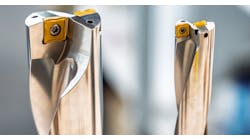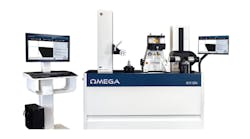Rockwell indent of ta-C coating shows excellent adhesion.
“Physical vapor deposition” (PVD) coatings are widely used to treat in cutting tools because of the wear-resistant properties they impart. Engineers and technicians have made considerable advances in the development of PVD coating thanks to “cross-fertilization,” meaning that technical advances in one area of research can advance the need of other markets. For example, the tooling market can gain from the advanced coatings developed for the automotive engine market. Dutch PVD specialist Hauzer Techno Coating recently applied its tribological coating technology to the tool market, with excellent results.
In many tool applications, coating hardness is critical, as is good coating adhesion. But, there are other features that can create advantages for coating. Non-sticking, for example, is very important when machining soft materials like aluminum or plastics because it enhances the lifespan of the tool and increases the productivity of the tooling equipment. Smoothness, on the other hand can be a huge advantage for forming tools because it can eliminate post-treatment. In automotive coating applications, these features have been extensively studied and coatings have been optimized as a result.
Diamond Like Carbon (DLC) coatings are widely used in automotive applications for their superior tribilogical features. The friction coefficient of DLC coatings is low and the material is non-sticking. Depending on the technology used to deposit the coating (sputtering, PACVD, arc evaporation), the features can be adapted to the application. DLC coating is very suitable for coating drills, inserts, end mills, saw blades, taps, punches, (plastic) molds and dies. Apart from its use in machining aluminum, DLC coating also can be used on tools for machining other non-ferrous metals and plastics.
Another example of technology transferred from one market to another is hydrogen-free DLC (ta-C). During the Nanocoat project, a European research program, to develop nanostructured coatings that use environmentally friendly deposition techniques, test were done with several different DLC coatings on automotive engine components (tappets). The tests, which were conducted at the FIAT Research Centre (CRF) in Turin, concluded that ta-C coatings were characterized by the highest hardness and showed the lowest friction coefficient. With the knowledge gained from the Nanocoat project, Hauzer (a research partner) has been able to solve the adhesion issues for ta-C. The result is a range of ta-C coatings with good adhesion and hardness values (40-70 Gpa with DB 1-2) that can be applied industrially.
During impact measurements by a large U.S. engine manufacturer, it turned out that the ta-C coating was still intact with an impact load of 2 kN, just some small cracks were visible. A benchmark coating had already been removed with this impact load. The photo shown here of the Rockwell indent reveals the good adhesion of the ta-C coating. The hydrogen-free ta-C coatings are produced by using arc technology, circular arc or laser arc, and have a diamond-like structure (mainly SP3). A typical hardness of 3,000-7,000 HV can be achieved with ta-C coatings. The typical friction coefficient is between 0.02 and 0.1.
The advantageous features of ta-C together with the solution for the adhesion issues make this a promising coating for precision tooling, according to Hauzer.






